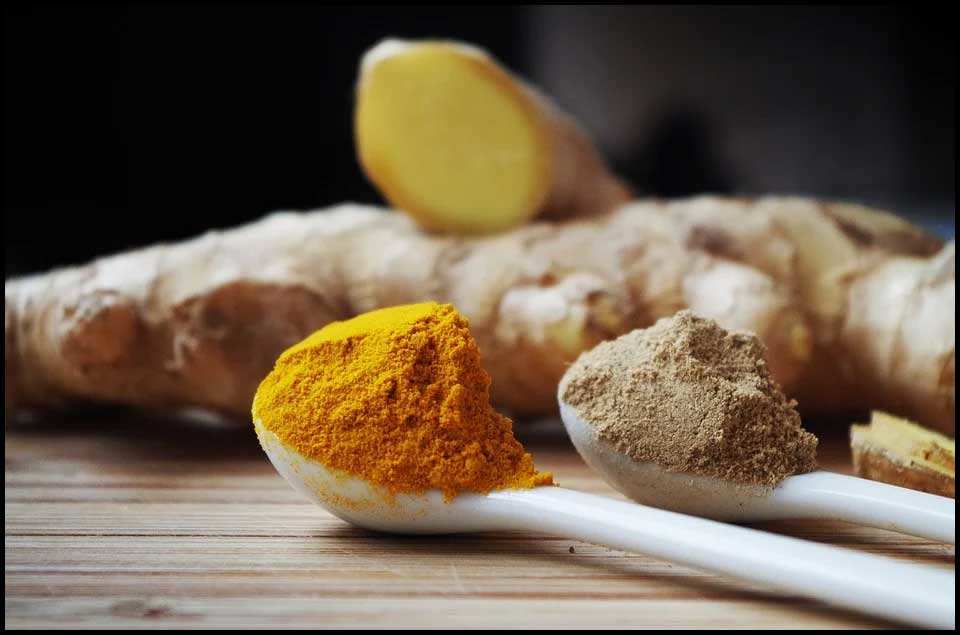
Are they pain cure-alls? No, but they may help ease your aching head, belly, or bones. Here’s what’s known about the medicinal qualities of ginger and turmeric, and how to incorporate them into your diet.
Both ginger and turmeric are rhizomes, or root stalks, used around the world, not only as food seasonings but also as traditional herbal medicines. As herbal remedies, both spices are used primarily to help alleviate different types of pain. Many scientific studies have been conducted to determine if and how each rhizome actually works. Although results have been mixed, there’s reason to believe that ginger and turmeric both contain active ingredients that can provide at least some relief to those suffering from a number of painful conditions, from arthritis and gastric discomfort to migraine headaches and post-surgical pain.
Ginger as a Go-To
The active medicinal ingredients in ginger are phytochemicals known as gingerols and shogoal. Ginger has long been used as an herbal remedy to relieve motion sickness, morning sickness, general nausea, and upset stomach and, more recently, post-surgical nausea and chemotherapy-induced nausea. Ginger has also been used to treat and prevent the growth of H pylori, the bacteria responsible for gastric infections and ulcers.
A study of 150 women with equally severe menstrual pain compared the pain-relieving properties of ginger to ibuprofen and a prescription NSAID (nonsteroidal anti-inflammatory drug) and found them to be equally effective. Another study found that ginger was just as effective as a common triptan medication used to treat many types of migraine headaches. Both powdered ginger and the triptan relieved headache pain within two hours. Research also suggests that regularly eating ginger can help relieve certain pain that comes with rheumatoid arthritis and osteoarthritis.
In addition to helping relieve pain, ginger may help to prevent some of the side effects associated with conventional painkillers as well. Long-term or high-dose use of aspirin and NSAIDs have been linked to stomach damage such as lesions, ulcers, and other gastrointestinal disorders. Research shows that the active compounds in ginger may help protect the lining of the stomach from damage due to these drugs, as well as alcohol and excess hydrochloric acid produced by the stomach in some conditions.
Working Ginger Into Your Diet
Several forms of ginger can be used to flavor foods and potentially reduce certain forms of pain. These include fresh gingerroot, powdered ginger, crystallized (sugared) ginger, and ginger juice. (To make ginger juice, shred a knob of fresh ginger over a strong paper towel; gather the shreds into a bundle and squeeze the juice out gently over a small bowl.) To routinely incorporate ginger into your diet:
- add peeled, fresh, or powdered ginger to fruit, vegetable smoothies, and shakes
- add powdered ginger or ginger juice to tomato juice or soup, lemonade, and hot or iced tea
- use fresh or powdered ginger in stir-fries, curries, and meat marinades (use small amounts at first, then adjust to taste)
- add chopped crystallized ginger to cereals, fruit salads, and nut-and-fruit mixtures, or eat out of hand
- use powdered ginger to make herbal tea.
Turmeric as a Pain Relief Tool
Turmeric is a commonly used spice in Southeast Asian cuisine, especially in Indian and Thai food. Curcumin, an active compound in turmeric, is known for its antioxidant and anti-inflammatory activity that can promote healing. Like ginger, studies have found that turmeric may have pain-reducing power equal in some cases to that of prescription and over-the-counter medications. In clinical studies, turmeric’s anti-inflammatory action appears to help improve rheumatoid arthritis, post-operative inflammation, Crohn’s disease, ulcerative colitis, irritable bowel syndrome, and stomach ulcers.
One animal study that looked at rheumatoid arthritis found that even though both turmeric and ginger reduced the incidence and severity of flare-ups, turmeric had significantly more anti-inflammatory and antioxidant power than ginger.
Working Turmeric Into Your Diet
Turmeric is available as a fresh root in specialty markets and as a dried, powdered spice in most regular grocery stores. It can be found in most curry powder mixtures. On its own, powdered turmeric powder has a dusty, bitter flavor that is generally unfamiliar to the western palate; fresh turmeric root is milder in flavor. Below are a few ways to incorporate turmeric into daily meals.
- To make a turmeric drink, mix ¼ teaspoon turmeric powder with 2 tablespoons of lemon juice and dilute with ½ to 1 cup warm water.
- Sweeten with a little honey or sugar, as desired. You might also consider adding a pinch or two of turmeric powder to rice, coleslaw, or scrambled eggs or omelets before cooking.
- dd a teaspoon or more of fresh turmeric (finely chopped or grated) to fruit and vegetable smoothies and juices, curry dishes, egg dishes, pureed vegetable soups (cauliflower, carrot, potato, split pea) and marinades for poultry.
- Turmeric also combines well with other seasonings, such as ginger, cinnamon, garlic, black pepper, cumin, and vinegar. Experiment by adding combinations of these seasonings to plain chicken or vegetable broth for a warming soup, or combine turmeric and ginger with hot water, milk, and honey for a comforting tea.
Supplements As An Option
If you wish to take ginger or turmeric supplement capsules, speak with your primary healthcare provider or health specialist first to find out if they are appropriate for your condition. Also, ask your provider about the type and dose that might be most effective for you. It’s important not to take too high a dose of either ginger or turmeric, as too much may cause indigestion or other side effects.
Sources:
- Prasanthi C, Prasanthi NL, Manikiran SS, Rao NR. Focus on current trends in the treatment of helicobacter pylori infection: An update. Intl J Pharmaceut Sci Rev Res. 2011;9(1);42-51.
- Ozgoli G, Goli M, Moattar F. Comparison of effects of ginger, mefenamic acid, and ibuprofen on pain in women with primary dysmenorrhea. J Alter Complement Med. 2009;15(2). Available at http://online.liebertpub.com/doi/abs/10.1089/acm.2008.0311.
- Maghbooli M, Golipour F, Esfandabadi AM, Yousefi M. Comparison between the efficacy of ginger and sumatriptan in the ablative treatment of the common migraines. Phytotherapy Res. 2014;28(3):412-415. Available at http://onlinelibrary.wiley.com/doi/10.1002/ptr.4996/full.
- Chatterjee A, Bandyopadhyay Herbal remedy: An alternate therapy of non-steroidal inflammatory drug induced gastric ulcer healing. Ulcers. 2014; ID 361586. Available at https://www.hindawi.com/journals/ulcers/2014/361586/.
- Bhatt N, Waly MI, Essa MM, Ali A. Ginger: A functional herb. January 2013. Available at http://allthingscanid.org/Ginger%20a%20functional%20herb.pdf.
- Epstein J, Sanderson IR, MacDonald TT. Curcumin as a therapeutic agent: the evidence from in vitro, animal and human studies. British J of Nutr. 2010;103:1545-1557. Available at https://www.cambridge.org/core/services/aop-cambridge-core/content/view/S0007114509993667.
- Ramadan G, Al-Kahtani, MA, El-Sayed WM. Anti-inflammatory and anti-oxidant properties of Curcuma longa (turmeric) versus Zingiber officinale (ginger) rhizomes in rat adjuvant-induced arthritis. Inflammation. 2011;34(4):291-301. Available at
- https://link.springer.com/article/10.1007/s10753-010-9278-0.
Important Notice: This article was originally published at www.practicalpainmanagement.com by Susan McQuillan, MS, RDN, CDN where all credits are due.
Disclaimer
The watching, interacting, and participation of any kind with anything on this page does not constitute or initiate a doctor-patient relationship with Dr. Farrah®. None of the statements here have been evaluated by the Food and Drug Administration (FDA). The products of Dr. Farrah® are not intended to diagnose, treat, cure, or prevent any disease. The information being provided should only be considered for education and entertainment purposes only. If you feel that anything you see or hear may be of value to you on this page or on any other medium of any kind associated with, showing, or quoting anything relating to Dr. Farrah® in any way at any time, you are encouraged to and agree to consult with a licensed healthcare professional in your area to discuss it. If you feel that you’re having a healthcare emergency, seek medical attention immediately. The views expressed here are simply either the views and opinions of Dr. Farrah® or others appearing and are protected under the first amendment.
Dr. Farrah® is a highly experienced Licensed Medical Doctor certified in evidence-based clinical nutrition, not some enthusiast, formulator, or medium promoting the wild and unrestrained use of nutrition products for health issues without clinical experience and scientific evidence of therapeutic benefit. Dr. Farrah® has personally and keenly studied everything she recommends, and more importantly, she’s closely observed the reactions and results in a clinical setting countless times over the course of her career involving the treatment of over 150,000 patients.
Dr. Farrah® promotes evidence-based natural approaches to health, which means integrating her individual scientific and clinical expertise with the best available external clinical evidence from systematic research. By individual clinical expertise, I refer to the proficiency and judgment that individual clinicians acquire through clinical experience and clinical practice.
Dr. Farrah® does not make any representation or warranties with respect to the accuracy, applicability, fitness, or completeness of any multimedia content provided. Dr. Farrah® does not warrant the performance, effectiveness, or applicability of any sites listed, linked, or referenced to, in, or by any multimedia content.
To be clear, the multimedia content is not intended to be a substitute for professional medical advice, diagnosis, or treatment. Always seek the advice of your physician or other qualified health providers with any questions you may have regarding a medical condition. Never disregard professional medical advice or delay in seeking it because of something you have read or seen in any website, video, image, or media of any kind. Dr. Farrah® hereby disclaims any and all liability to any party for any direct, indirect, implied, punitive, special, incidental, or other consequential damages arising directly or indirectly from any use of the content, which is provided as is, and without warranties.








